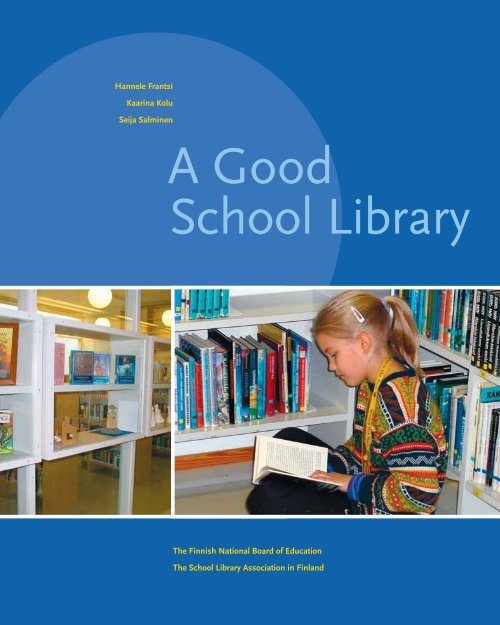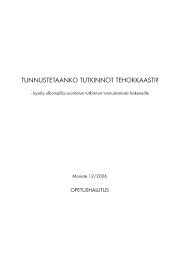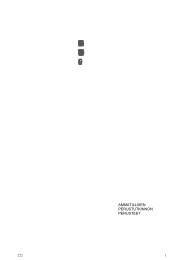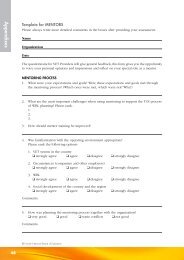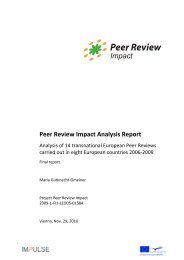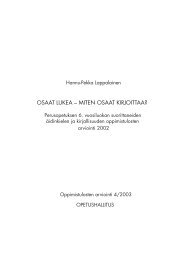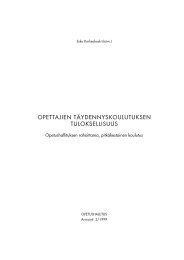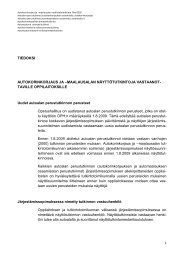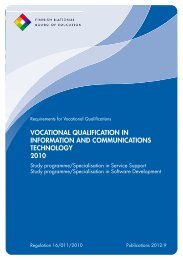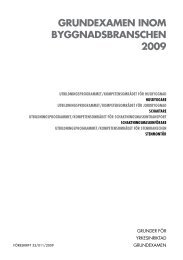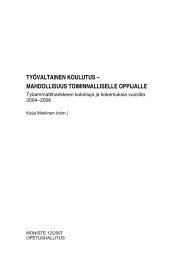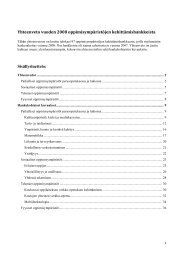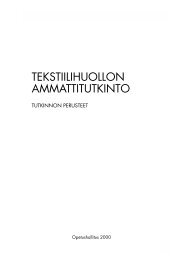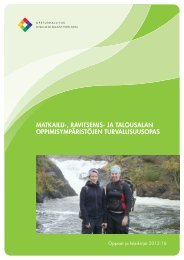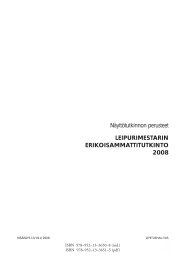School Library A Good
School Library A Good
School Library A Good
Create successful ePaper yourself
Turn your PDF publications into a flip-book with our unique Google optimized e-Paper software.
Hannele Frantsi<br />
Kaarina Kolu<br />
Seija Salminen<br />
A <strong>Good</strong><br />
<strong>School</strong> <strong>Library</strong><br />
The Finnish National Board of Education<br />
The <strong>School</strong> <strong>Library</strong> Association in Finland
Contents<br />
3<br />
4<br />
9<br />
11<br />
19<br />
Introduction: Better school libraries for Reading Finland<br />
Towards a good school library<br />
– characteristics of a good school library<br />
Who decides what<br />
– doers and doing<br />
The heart of the school<br />
– facilities, equipment and material of a school library<br />
The sky is the limit<br />
– school library, culture for all<br />
A <strong>Good</strong> <strong>School</strong> <strong>Library</strong><br />
Text:<br />
Hannele Frantsi<br />
Kaarina Kolu<br />
Seija Salminen<br />
Publishers:<br />
The <strong>School</strong> <strong>Library</strong> Association in Finland<br />
The Finnish National Board of Education<br />
<strong>School</strong> libraries featured in photographs<br />
are of schools in Espoo.<br />
Photography: Hannele Frantsi<br />
Layout: Heikki Sallinen/Logopolis<br />
Original publication: Hyvä koulukirjasto, 2002<br />
Translation from Finnish: Anu Harju<br />
ISBN 952-13-2716-2 (pdf)<br />
<br />
A <strong>Good</strong> <strong>School</strong> <strong>Library</strong>
Better school<br />
libraries for<br />
Reading Finland<br />
The aim of the Reading Finland project, one of the top projects<br />
of the education administration, is to improve the reading<br />
and writing skills of pupils in both basic and upper secondary<br />
education. An effective way of reaching that goal is to update school<br />
libraries and to improve collaboration between school libraries and the<br />
municipal library.<br />
Of all the participating municipalities 50 have decided to begin<br />
developing their school libraries. The school library network is becoming<br />
the largest topic network of the Reading Finland project. It seems that<br />
now at the beginning of the 21st century schools and municipalities have<br />
understood the significance and function of the school libraries in<br />
supporting teaching and learning as well as in developing the information<br />
management and reading and writing skills of the pupils.<br />
There have been some promising and inspiring school library solutions<br />
in individual schools already. Some of the most active municipalities<br />
have eagerly begun developing the information society’s school libraries,<br />
media labs and information booths and centres… Bold and extensive<br />
municipal projects already exist at least in Espoo, Oulu and Kuopio.<br />
Hopefully, others will follow suit.<br />
This joint publication by The <strong>School</strong> <strong>Library</strong> Association in Finland<br />
and The National Board of Education offers the municipalities and<br />
schools officially partaking in the project as well as others interested in<br />
the matter both a vision for development and practical description and<br />
instruction on what a well-functioning school library is like. The leaflet<br />
‘A <strong>Good</strong> <strong>School</strong> <strong>Library</strong>’ draws mainly on the experiences gained by the<br />
people of Espoo during the building of model school libraries and the<br />
continuing training of teacher-information officer staff. With the aid of<br />
the publication ‘A <strong>Good</strong> <strong>School</strong> Libarary’ The Finnish National Board of<br />
Education hopes to create better school libraries for Reading Finland.<br />
Reading week 2002<br />
Pirjo Sinko<br />
Counsellor of Education<br />
Finnish National Board of Education<br />
Hyvä koulukirjasto
Towards a <strong>Good</strong><br />
<strong>School</strong> <strong>Library</strong><br />
– Characteristics of a good school library<br />
A school library is an<br />
organised collection of study<br />
and teaching material aimed<br />
at pupils, teachers and other<br />
staff alike. It also includes<br />
access to local, regional,<br />
national and international<br />
information databases. The<br />
facilities, material, equipment<br />
and staff of the school library<br />
as well as its operations are<br />
organised in such a way that<br />
they support learning within<br />
the pedagogic goals of the<br />
school. In support of the<br />
reforming of a school library<br />
the following is an inspection<br />
of the characteristics of a good<br />
school library.<br />
What’s in a name<br />
We have many names for the things we love, as does the<br />
school library of today. The array of names may seem confusing,<br />
but the variety is best interpreted as reflecting new ways of<br />
doing things, different emphasis and aspiration towards<br />
reform in its entirety. What is more essential than the naming<br />
is what the school library is like and what happens there. In<br />
this publication the term ‘school library’ covers the whole<br />
array. The illustration shows a few of the terms currently in<br />
use that all refer to a school library. A proper name may also<br />
be an apt choice.<br />
Winds of change<br />
The demand for developing school libraries come from various<br />
directions; the Basic Education Act and the General Upper<br />
Seconday <strong>School</strong>s Act, the national information strategy, a<br />
<br />
A <strong>Good</strong> <strong>School</strong> <strong>Library</strong>
eport by the Ministry of Education, the evaluation results of<br />
the current state of the school libraries and the recent Unesco<br />
<strong>School</strong> <strong>Library</strong> Manifesto, among others. In 1998 when<br />
Parliament decided on the current Basic Education Act and<br />
the General Upper Seconday <strong>School</strong>s Act it also made several<br />
statements obligating in nature. One of the statements<br />
concerns school library and information services, i.e. the<br />
school library. The language of the Act is vague but the tone<br />
of the statement is obligating. The aforementioned statement<br />
has not received sufficient attention, even though it is still<br />
valid and independent of the changes in the composition of<br />
Parliament. The statement cannot be repealed by any other<br />
means than legislation. Thus the school library activity is<br />
statutory and cannot be called into question.<br />
Section 47 Supportive activities<br />
<strong>Library</strong>, club and other activities closely relating to education<br />
may be arranged in conjunction with basic education.<br />
Statement n:o 6 / in conjunction with the<br />
aforementioned legislation<br />
Parliament stipulates that the Ministry of Education place<br />
emphasis on the development of school library and<br />
information services with sufficient breadth as part of the<br />
pedagogic development of teaching<br />
The Information Strategy for Education and Research<br />
1999–2004 published in 1999 by the Ministry of Education<br />
and Finland can read published in 2000 by the Literacy in<br />
Information Society workgroup set guidelines that envision<br />
the direction of the development of school libraries and also<br />
set concrete goals for this development.<br />
The assessments made of the state of school libraries in<br />
Finland have never been flattering. With the growing amount<br />
of international connections we have come to realise that<br />
perhaps our school library culture to date would not stand a<br />
chance in international comparison. There is still a lack of<br />
comprehensive comparative material and existing material is<br />
not good either as is evident, for example, in an assessment<br />
carried out by the University of East Anglia on the curriculum<br />
reform (Norris 1996) and an assessment study related to the<br />
prerequisites for learning (Korkeakoski 2001) ordered in 2000<br />
by the National Board of Education.<br />
The former is amazed at the bad condition and age of the<br />
book collections and how the teaching methods are frozen<br />
to suit the books. The latter study reaches similar conclusions<br />
based on recent and extensive analyses on the current state<br />
of school libraries in lower basic education schools.<br />
The United Nations Educational, Scientific and Cultural<br />
Organization has approved the Unesco <strong>School</strong> <strong>Library</strong><br />
Manifesto 1998, which takes a strong position on school<br />
libraries globally. The Finnish Unesco committee is responsible<br />
for the Manifesto having been translated into Finnish, its<br />
publication and distribution. It can be found in its entirety on<br />
the internet at the following website www.minedu.fi/opm/<br />
unesco/sopimusluettelo.html. Many of the school libraries<br />
that suffered during the depression of the early 90’s would<br />
be severely reprimanded were they judged by the<br />
recommendations declared in the Manifesto (see overleaf).<br />
Look to the stars – Full steam ahead<br />
Factors independent of the school itself, such as were<br />
mentioned before, create obligations for improving the state<br />
of school libraries. What is it, then, that guides the development<br />
within the functioning of the school and in which direction<br />
Who benefits from this Why is the school library so important<br />
The recent changes in the learning culture have connections<br />
with the school library reform.<br />
• There has been fine tuning regarding the ideas of knowledge<br />
and learning.<br />
• The idea of the relationship between learning and teaching<br />
has deepened.<br />
• We know more about different learning strategies.<br />
• Methods and working habits have become more varied.<br />
• The idea of a learning environment and learning material<br />
has expanded.<br />
• Research has provided more information on effective<br />
learning and schooling.<br />
• The growing feeling of community creates a challenge for<br />
schools as well.<br />
• Internationality and multinationality are here to stay.<br />
– A good school library is the present and the future of the<br />
developing learning culture.<br />
A <strong>Good</strong> <strong>School</strong> <strong>Library</strong>
Extracts from the<br />
Unesco <strong>School</strong> <strong>Library</strong> Manifesto<br />
The Mission of the <strong>School</strong> <strong>Library</strong><br />
The school library offers learning services, books and resources that<br />
enable all members of the school community to become critical thinkers<br />
and effective users of information in all formats and media. <strong>School</strong><br />
Libraries link to the wider library and information network in accord<br />
with the principles in the UNESCO Public <strong>Library</strong> Manifesto.<br />
The library staff supports the use of books and other information<br />
sources, ranging from the fictional to the documentary, from print to<br />
electronic, both on-site and remote. The materials complement and<br />
enrich textbooks, teaching materials and methodologies<br />
As the responsibility of local, regional and national authorities, the<br />
<strong>School</strong> <strong>Library</strong> must be supported by specific legislation and policies.<br />
<strong>School</strong> Libraries must have adequate and sustained funding for trained<br />
staff, materials, technologies and facilities. Where the school library<br />
shares facilities and/or resources with another type of library, such as<br />
a public library, the unique aims of the school library must be<br />
acknowledged and maintained.<br />
The school library is integral to the educational process. The following<br />
are essential to the development of literacy, information literacy, teaching,<br />
learning and culture and are core school library services:<br />
• supporting and enhancing educational goals as outlined in the<br />
school's mission and curriculum;<br />
• developing and sustaining in children the habit and enjoyment of<br />
reading and learning, and the use of libraries throughout their lives;<br />
• offering opportunities for experiences in creating and using information<br />
for knowledge, understanding, imagination and enjoyment;<br />
• supporting all students in learning and practising skills for evaluating<br />
and using information, regardless of form, format or medium,<br />
including sensitivity to the modes of communication within the<br />
community;<br />
• providing access to local, regional, national and global resources<br />
and opportunities that expose learners to diverse ideas, experiences<br />
and opinions;<br />
• organizing activities that encourage cultural and social awareness<br />
and sensitivity;<br />
• working with students, teachers, administrators and parents to<br />
achieve the mission of the school;<br />
• proclaiming the concept that intellectual freedom and access to<br />
information are essential to effective and responsible citizenship and<br />
participation in a democracy;<br />
• promoting reading and the resources and services of the school<br />
library to the whole school community and beyond.<br />
National curriculum reform brings forth development targets<br />
that will benefit from the updated library and information<br />
services of the schools.<br />
• Pupils’ working methods have become an object of<br />
evaluation<br />
• Information management, co-operation and interaction<br />
skills are seen as skills of the future. Working methods<br />
characteristic of a school library is a continuum in the<br />
learning and work culture.<br />
• Integration and new cross-curricular themes require the<br />
availability of unconventional learing material, its<br />
management and the skills for using it.<br />
• At their own pace learning, individual study paths and<br />
personal study plans also require individualised choices<br />
regarding learning material.<br />
• The demand for knowledge about health, welfare and<br />
upbringing is growing; material in common use and<br />
collaborative working methods that activate pupils are in<br />
demand. Making a connection with parents in the company<br />
of up-to-date educational books on upbringing is wise.<br />
• The increased amount of teaching hours of mother tongue<br />
and literature, history and social studies as well as<br />
mathematics together with the reformed objectives are in<br />
line with the school library developing into a media centre<br />
conscious of its function as a sophisticating body<br />
• The share of teaching cultural views as a part of ethics<br />
teaching is on the increase. It is a common cause for the<br />
whole school to offer objective information about the<br />
multicultural world we live in. A well organised school<br />
library facilitates teaching arrangements<br />
• The new distribution of lesson hours offers less choice and<br />
brings with it different emphasis and optional studies that<br />
are more thought out. The school library can support in<br />
its own area the credibility of the school profile.<br />
– Do the working methods and the material of the school library<br />
support the basic function of the school or its profile Does<br />
the school library meet the challenges posed by the new<br />
curriculum<br />
To ensure effective and accountable operations:<br />
• the policy on school library services must be formulated to define<br />
goals, priorities and services in relation to the school's curriculum;<br />
• the school library must be organized and maintained according to<br />
professional standards;<br />
• services must be accessible to all members of the school community<br />
and operate within the context of the local community;<br />
• co-operation with teachers, senior school management,<br />
administrators, parents, other librarians and information professionals,<br />
and community groups must be encouraged.
Core topics<br />
Subjects<br />
Projects<br />
Cross-curricular themes<br />
Themes<br />
A good school libarary<br />
helps to integrate<br />
Content areas<br />
Integrated teching<br />
<strong>School</strong>s have a growing number of special needs arising from<br />
their own activities; needs that a good school library will be<br />
able to answer.<br />
• Pupils with immigrant background need material that<br />
supports their cultural and linguistic background during<br />
the school day.<br />
• Becoming more international increases teaching in foreign<br />
languages, which creates its own needs as regards material.<br />
• Pre-primary education is arranged within schools more<br />
and more, and the younger school goers have their own<br />
special, delicate even, relationship with the language<br />
environment and literature. To cherish the budding reading<br />
and writing skills of young pupils the school library should<br />
be carefully equipped with children’s interests in mind.<br />
• The needs of SEN (Special Educational Needs) pupils also<br />
show up as a need for different teaching and study materials.<br />
As the integrational solutions increase the teaching groups<br />
become more heterogenic. Well organised, diverse support<br />
material in common use facilitates differentiation.<br />
• The school’s club activities as well as organising the<br />
afternoon clubs also benefit from a good school library<br />
What do the pupils benefit from a school library<br />
• They get acquainted with organised information.<br />
• They get to know different information sources and learn<br />
to use these selectively.<br />
• They find quality prose suitable for their age.<br />
• They familiarise themselves with the possibilities different<br />
media offer.<br />
• They will have access to databases and information networks<br />
outside of school.<br />
• They have the possibility to concentrate on their own<br />
assignment in peace.<br />
• They receive guidance when needed.<br />
• They learn different forms of collaborative working methods.<br />
• They learn to evaluate the reliability of information.<br />
• They learn to use the common material in a responsible<br />
way.<br />
• They can refresh themselves and relax in the school library.<br />
– In a good school library the pupil will grow to be a skillful user<br />
of the information services, who is also curious, selective,<br />
critical, shows initiative, is co-operative and responsible. A<br />
good school library strengthens good study habits.<br />
What does the teacher benefit from the school library<br />
• A natural forum for co-operation opens up to the teacher.<br />
• Possibilities for new working methods become available<br />
to the teacher.<br />
• The teacher may find new perspectives regarding the object<br />
of study.<br />
• The teacher can find new information and also update<br />
previous knowledge.<br />
• The teacher’s information management skills are developed.<br />
• The teacher’s professionalism as a user of information<br />
services increases.<br />
• The teacher learns to give pupils information retrieval tasks<br />
that are more meaningful for the pupils.<br />
• The teacher can get acquainted with the pupils from a new<br />
perspective.<br />
• The teacher can relax, refresh and recharge in a good school<br />
library, too.<br />
– A good school library supports the professional growth of<br />
teachers, their co-operation and knowledge of their pupils. At<br />
best, it can also add to work satisfaction and enjoyment.<br />
A good school library is a meeting point for the whole<br />
community.<br />
A <strong>Good</strong> <strong>School</strong> <strong>Library</strong>
Language groups<br />
Different learners<br />
Learning strategies<br />
Personnel groups<br />
Pupils and staff<br />
Cultures<br />
Fact and Fiction<br />
Ethics<br />
A good school library<br />
is a meeting point<br />
The past and the future<br />
Cross-curricular themes and subjects<br />
Pre-primary education and school<br />
Clubs and afternoon activities<br />
<strong>School</strong> and library<br />
Student association<br />
Home and school<br />
Guidance counselling<br />
A school library has a special character that differs from that<br />
of other libraries.<br />
• The starting point for the activity is the curriculum – not<br />
the general sophisticating service of the municipality.<br />
• A school library is a part of the school – not an independent<br />
unit.<br />
• The location within the school building should be as central<br />
as possible – not at a distance.<br />
• The target groups are the pupils and the teachers – not<br />
the whole population of the area.<br />
• The library activity reaches tho whole age group – not only<br />
the ones who voluntarily seek it.<br />
• Working methods are pedagogically justified – not service<br />
oriented.<br />
• The library is used by the whole class, as a group,<br />
independently – seldom optionally<br />
• The material is specific and limited – not extensive and<br />
aiming at high rate of borrowing.<br />
• In developing the school library and the school’s information<br />
and communications technology we receive fringe benefits<br />
that all belong under the umbrella term shared information<br />
strategy.<br />
– The special nature of the school library needs to be<br />
acknowledged as a part of the pedagogic development of the<br />
school.<br />
A <strong>Good</strong> <strong>School</strong> <strong>Library</strong>
Who<br />
decides<br />
what<br />
– doers and doing<br />
In developing the school library many people have an important<br />
role to play both in the school and the groups affiliated with<br />
it. One person cannot change the learning culture of the<br />
school. For this reason it is important for the school library<br />
development work to have a multi-professional team that<br />
focuses on the task and represents the needs of the entire<br />
school.<br />
1. Headmaster<br />
• decides on the budget for the school library<br />
• supports the development of the school library<br />
• co-ordinates the further education of the staff<br />
• keeps in touch with the board of the municipal educational<br />
administration<br />
• guides the drawing up of the school curriculum<br />
2. <strong>School</strong> librarian, library-teacher<br />
• acquires and removes material<br />
• organises the catalogueing, covering the books with plastic<br />
and other book maintenance work<br />
• organises the borrowing<br />
• arranges teaching in the school library (information retrieval,<br />
data management, enticing pupils to read)<br />
• leads the school library team<br />
• acts as a liaisons officer between the library and the school<br />
3. ICT-teachers and ICT- contact persons (helpdesk)<br />
• are part of the school library team<br />
• help and guide pupils in using the computers, especially<br />
in the library<br />
• participate in teaching how to retrieve information<br />
• maintain the computers in the school library<br />
4. Guidance councellor and upper secondary school guidance<br />
counsellor<br />
• guide pupils in study skills<br />
• are part of the school library team<br />
• teach information retrieval<br />
<br />
A <strong>Good</strong> <strong>School</strong> <strong>Library</strong>
The international school<br />
library day is celebrated<br />
annually on the 4th<br />
Monday in October.<br />
IASL International Association of <strong>School</strong><br />
Librarianship www.iasl-slo.org/<br />
5. <strong>School</strong> library team<br />
• headmaster, library teacher(s), guidance councellor, ICTteacher,<br />
representatives of different subjects<br />
• together they plan the activity of the school library<br />
• plans the division of labour within the team (especially if<br />
the school does not have a school librarian)<br />
• draws up the school curriculum as it concerns the school<br />
library<br />
• gathers a ’wish list’ from the different user groups of the<br />
school library regarding the acquisition of material<br />
• evaluates the activities and function of the school library<br />
• defines the rules for the school library (borrowing, fees,<br />
opening times) and the library etiquette<br />
6. Trusted pupils<br />
• act as contact persons between the pupils and the teacherlibrarian<br />
• participate partly in the activities of the school library team<br />
• carry out assistant duties in the school library<br />
• organise exhibitions of the pupils’ work in the school library<br />
7. The board, the parents’ association and the school<br />
committee<br />
• support the development of the school library<br />
• collect money for the school library<br />
• arrange for visiting authors etc. to support the library<br />
activities<br />
• participate in the planning of the school library activities<br />
• do voluntary work in the school library<br />
8. The municipal education authorities<br />
• are responsible for the centred development of school<br />
libraries in the municipality<br />
• plan and organise the acquisition of the common library<br />
system and the catalogueing in the schools<br />
• organise teachers’ further education regarding school<br />
library matters and teaching information management<br />
skills<br />
• issue guidelines regarding the organisation of acquisition<br />
of material (place of acquisition, system of acquisition)<br />
• co-ordinate collaboration between the library administration<br />
and the education administration<br />
9. The municipal library authorities<br />
• collaborate with the education administration (library<br />
system, catalogue information, common agreements<br />
concerning the the use of databases, etc.)<br />
• name the liaisons officers for the school libraries and the<br />
public library<br />
• perform educational collaboration with the educational<br />
administration<br />
An example from Espoo:<br />
20 doors into learning – teacher-information officer training<br />
• a two-year training programme for teachers in Espoo,<br />
extent 20 study weeks<br />
• training carried out in collaboration with the Turku<br />
Polytechnic<br />
• teachers become competent in acting as school librarians<br />
and as teachers of information management skills<br />
A <strong>Good</strong> <strong>School</strong> <strong>Library</strong>
heart<br />
– facilities, equipment and material<br />
of a school library<br />
The<br />
of the school<br />
The objectives of the school library activity<br />
• to create an aesthetically pleasing as well as practical<br />
learning environment<br />
• to provide access to sources of varied, current and useful<br />
information for both pupils and teachers<br />
• to arrange the possibility to study information management<br />
skills, which forms a basis for lifelong learning<br />
• to encourage reading for pleasure<br />
The school library is a flexible learning<br />
centre open for everyone working in the<br />
school<br />
The school library needs to be in an architectually central<br />
location in the school, in the heart of the school, where it is<br />
easy and pleasant for anyone to go. There should be facilities<br />
in conjunction with the school library that enable multiform<br />
learning:<br />
• Computer classroom may open into the library.<br />
• Teamwork area where pupils can have discussions without<br />
disturbing other people in the library; it could be sectioned<br />
off with glass.<br />
• Teachers’ work area where teachers can copy, prepare study<br />
material and at the same time see into the school library<br />
will enhance the versatility of the library.<br />
• Storeroom for teaching aids could be located in the vicinity<br />
of the school library.<br />
• There may also be an area where shows aimed at an<br />
audience may be performed, a space that transforms into<br />
a stage, a puppet show or a story time location.<br />
• Facilities required for editing audio and visual recordings<br />
are located near the library (secondary education)<br />
• Science classroom in primary education with all the<br />
microscopes and observation equipment can also be located<br />
near the library as they are both places for exploration.<br />
It would be good if at least one teaching group fits to work<br />
in the school library at any one time. A good school library is<br />
flexible and welcoming. The needs vary over the course of the<br />
school year and terms.<br />
A <strong>Good</strong> <strong>School</strong> <strong>Library</strong>
If the shelves are moveable and the electric solutions for<br />
the space are planned properly the tables can be easily put<br />
together in different ways and the school library will be able<br />
to accomodate the changing needs of teaching without major<br />
renovations over the years.<br />
Different learning strategies are taken into account in both<br />
the visual and the functional setting of the school library<br />
• Information is organised according to certain criteria to<br />
make locating it as easy as possible for the library user,<br />
e.g. PLC system i.e. the Finnish Public Libraries Classification<br />
System or UDC system i.e. the Universal Desimal<br />
Classification System.<br />
• The pupils are taught the classification system used in the<br />
school library as well as how to use it at school.<br />
• Classification done in conjunction with the compilation of<br />
the material catalogue may be different from the location<br />
marking (signum) i.e. the books may be placed in the<br />
shelves according to different crtiteria than what is used<br />
in the classification system, e.g. by themes (pedagogic<br />
starting point).<br />
• The planning of acoustics, lighting and electricity, air<br />
conditioning and maintenance should be done properly.<br />
• Different age groups taken into consideration when planning<br />
for furniture and classification system (the height of the<br />
shelves, chairs and tables, ergonometry).<br />
• The areas emphasised by the school curriculum are taken<br />
into consideration.<br />
• The school policy is reflected in the school library.<br />
• Presentation of the material is tempting and clear (short<br />
rows of shelves are easier to perceive than long rows, space<br />
and light around the shelves)<br />
An example from a model school library in Espoo<br />
• In primary education school libraries the nonfiction books are<br />
classified and placed on the shelves according to the PLC, but<br />
on the side of the shelf there is the name of the class, which is<br />
replaced by concepts that children understand. The number<br />
classification is not necessarily even on show but there may be<br />
a colour code on the back of the book.<br />
• In primary education prose is classified thematically on the<br />
shelves with stickers on the back of the book, e.g. fantasy (a<br />
dragon), horror (a skull), love (a heart).<br />
• Secondary education school libraries follow the PLC system<br />
both on the shelves and in the catalogueing , the shelf<br />
classification on the edge of the shelf together with the PLC<br />
term.<br />
The three functional areas of<br />
the school library<br />
1. Managing the collection<br />
• school librarian’s desk, cupboard, storeroom depository,<br />
reception of books<br />
• library programme: catalogueing, borrowing<br />
• working area, where one can maintain and handle books<br />
(repairing, covering books with plastic, catalogueing)<br />
2. Information retrieval<br />
• reference resources (nonfiction books, magazines, cd-roms)<br />
• computers equipped with internet connection for<br />
information retrieval<br />
• access to e.g. material and article databases<br />
• tables for working<br />
• group work areas, where the group can work together and<br />
have discussions whilst working<br />
• a quiet area for doing homework, or for listening for tapes<br />
and compact discs with headphones<br />
3. Reading<br />
• new and interesting children’s, youth and adult literature<br />
for all kinds of readers placed according to the library<br />
classification system<br />
• areas where pupils of different age easily find reading to<br />
suit their purposes:<br />
• pre-primary and primary education area has low shelves<br />
and the books clearly on show, e.g. the cover facing the<br />
viewer<br />
• in the area aimed at the older readers the classification of<br />
books by themes, thematic shelves, e.g. fantasy, love and<br />
friendship, adventure, nature, comic books, etc.<br />
• magazine rack where magazines targeted at different age<br />
groups (children, youth, adults) can be found (nature,<br />
animals, games, computers, youth, science, art, motors<br />
and engines, sports, music, cinema, culture, etc.) and at<br />
least one newspaper.<br />
• comfortable seats for sitting, browsing and reading in<br />
comfort and with enjoyment<br />
• a place for having story time sessions, book reviews to<br />
promote reading for pleasure, and telling stories<br />
• in upper secondary schools also a newspaper room with<br />
tables for reading together<br />
A <strong>Good</strong> <strong>School</strong> <strong>Library</strong>
Collection work and the<br />
management of the collection<br />
The basis of the collection work in the school library is planning<br />
with an analysis of the school and the community as its<br />
starting point. The plan outlines the school library operations<br />
policy and general<br />
directives regarding the<br />
• selection of material<br />
• acquisition of<br />
material<br />
• elimination of<br />
material<br />
• evaluation of<br />
material<br />
An analysis of the<br />
school community<br />
carried out with care enhances the school library collection’s<br />
ability to cater for the varying needs of different users equally.<br />
The school library user group also includes minory groups of<br />
the community: ethnic groups, religious groups, different<br />
SEN pupil groups (e.g. dyslexia, visually impaired), different<br />
groups divided by emphasis, optional subject or a hobby. The<br />
community analysis for the collection work plan includes<br />
clarification of and limiting of the form of collaboaration and<br />
areas of operations of school libraries and the public library.<br />
Factors that influence this are for example the following<br />
• distance between the school library and the public library<br />
• facilities of the school library and the public library<br />
• staff resources of the school library and the public library<br />
• services offered to school by the public library (e.g.<br />
transferable collection mobile library<br />
plan of action. <strong>School</strong> libraries may concentrate on the classics<br />
and the fundamental works, whose time and capacity of use<br />
is great.<br />
The school library collection may contain for example<br />
• nonfiction literature as well as study and work books<br />
suitable for reference library that vary in their level of<br />
difficulty<br />
• selections of stories, tales, short stories and poetry suitable<br />
for different age groups; classics; changing selection of<br />
children’s books and youth literature for pre-primary and<br />
primary education class rooms; and some of the new novels<br />
• newspapers and magazines that prerequire different reading<br />
and language skills<br />
• brochures, reports, yearbooks and annuals<br />
• good quality student work<br />
• slides, compact disc video, micro films<br />
• video tapes (right of use obtained e.g. Finnish Broadcasting<br />
Company’s educational videos)<br />
• dvd recordings<br />
• compact discs , tape cassettes and audio book<br />
• cd-roms, e-books<br />
• floppy discs and computer programmes<br />
• Internet and tv-channels<br />
• pedagogic and psychological literature<br />
In addition the school library may have special collections<br />
which may contain<br />
• rare and unusual books<br />
• historical books donated by parents and students<br />
• archive material<br />
• books by local authors or pupils of the school<br />
SELECTION AND ACQUISITION OF MATERIAL<br />
It is especially important to have a well equipped and<br />
professionally maintained school library in schools that are<br />
relatively far from the nearest public library or whose pupil<br />
count is large in relation to the resources of the public library.<br />
The essential principle of the division of labour between the<br />
school library and the public library is avoiding overlapping<br />
material acquisition and activities. Public libraries aim at<br />
satifying the needs and wishes of the whole municipality; the<br />
focus of the school library is on the needs of the members of<br />
the school community relating to the school curriculum and<br />
A <strong>Good</strong> <strong>School</strong> <strong>Library</strong><br />
The selection and acquisition of material for the school library<br />
are regulated by the school library purchasing plan and the<br />
school library budget. The school library purchasing plan<br />
determines how the budget is divided up and distributed for<br />
acquiring different material. Is it good to agree on a general<br />
level how much of the purchasing appropriation in the budget<br />
is reserved for<br />
• nonfiction books of different fields (PLC/subject groups)<br />
• prose (including audio books and e-books),<br />
• audio and visual and multimedia material<br />
• newspapers and magazines.
Occasionally when selecting material the purchases need to<br />
be prioritised according to urgency, and order of acquisition<br />
is obtained by classifying the selection criteria:<br />
• applicability criteria: the purposefulness of the material for<br />
teaching and learning<br />
• content criteria: reliability of material, relevance and topicality;<br />
what added value does the material bring to the collection;<br />
how interesting the material is from the user perspective;<br />
the level of quality of information provided by the material<br />
• school based criteria: in what way does the material support<br />
and relate to the curriculum based goals of the school or<br />
the courses in the school; how does the material<br />
complement the school library collection in both content<br />
and quality<br />
• user criteria: does the material take into account the age,<br />
level of mental and social development, level of knowledge<br />
needed and learning strategies of the user group<br />
• suitability criteria: what is the reputation of the publisher,<br />
the author and the book like; how important is it to have<br />
the material available in the school library<br />
• price criteria: the reason for acquiring the material, urgency,<br />
comparing prices and the availability of material all figure<br />
in choosing between items<br />
The same selection criteria are used at all times when<br />
expanding the school library sollection, including donations<br />
and student work.<br />
The library service and a few other publishers have published<br />
guide books and bibliographies to help with the acquisition<br />
of material for a school library. In addition to the printed<br />
material there is a lot of information available on the web<br />
pages of different libraries.<br />
• Nonfiction books<br />
• Picture books and stories<br />
• Children’s books and youth literature:<br />
• Collections of children’s books and youth literature:<br />
• Children’s poetry<br />
• Suspense and horror<br />
• Fantasy and sci-fi<br />
• Finnish adult literature:<br />
• Foreign adult literature<br />
• Collections of adult literature<br />
• Poetry<br />
Multimedia, voice and picture recordings, educational<br />
programmes and games suitable for teaching purposes also<br />
belong to the school library. Presentations and reviews of cdroms<br />
aimed for children and youth are worth looking up on<br />
the web pages of the public libraries (e.g. Teuvo). These pages<br />
also have information on music recordings (e.g. Infoplaneetta).<br />
The collection in the school library is built for a clear-cut and<br />
small community. The basis for purchases may also be the<br />
information gathered from the target audience, for example<br />
• questionnaires<br />
• letterbox for acquisition wishes<br />
• mail box on the school library’s web pages<br />
• brainstorming of the multi-professional library team<br />
If the school community feels that the school library is a<br />
common cause the responsibility for the school librarian’s<br />
material acquisition work is divided between all the members<br />
of the school community. The same information sources used<br />
in the public libraries may well be used as the basis for material<br />
acquisition for the school library.<br />
A <strong>Good</strong> <strong>School</strong> <strong>Library</strong>
ELIMINATION OF MATERIAL<br />
The acqusition of a good quality school library collection<br />
requires good and well thought out purchases, but also proper<br />
elimination. One has to dare to make eliminations even in a<br />
school library regularly and systematically. Elimination should<br />
concern material that is<br />
• in bad condition<br />
• dated due to either language or terminology<br />
• contains dated information<br />
• has an old fashioned layout<br />
Some part of the dated material may have its own place and<br />
use in the school library’s special collection. The majority of<br />
the eliminated material ends up in paper recycling unless, for<br />
example, the student association organise a venue for selling<br />
the eliminated books.<br />
The selling time of a book in Finland is a couple of years,<br />
which leads to difficulties in trying to replace eliminated<br />
material in order to complement the collection with older<br />
material as it is no longer available in book shops. There are<br />
some tips on material which is no longer on sale in book<br />
shops on the web pages of public libraries that might be<br />
useful for a shool library; one can also find information by<br />
using search engines such as Teuvo, Kakaravaara or Makupalat.<br />
For example the contact details of second-hand book shops<br />
and their web pages can be found under www.kirjastot.fi/<br />
linkkikirjasto. You can find information on individual secondhand<br />
book shops’ sales catalogues as well as price guides for<br />
older literature published in book form.<br />
• Many of the magazines also offer new and up-to-date<br />
information from various fields in a form suitable for<br />
children.<br />
• <strong>Good</strong> quality student work by older pupils (e.g. essays,<br />
reports, interviews, group work) may be added to the<br />
collection following the general selection criteria and also<br />
made keyword searchable in the database.<br />
Different criteria can be used in evaluating how extensive<br />
should the material be for it to be sufficiently so. The following<br />
may be considered<br />
• is the collection sufficient enough to answer some of the<br />
questions and fulfil some of the wishes of the pupils<br />
• is current and up-to-date material available in different<br />
fields<br />
• is there sufficient amount of material in relation to the<br />
amount of users<br />
• does the collection contain certain classics and sources,<br />
fundamental literary works<br />
• does the material in the collection stimulate pupils enough<br />
to develop an interest in literature<br />
• does the material offered by the collection meet the<br />
demands of different user groups and cater for their interests<br />
• does the material in the collection represent different views<br />
and opinions, cultural and political points of view equally<br />
• does the collection support the implementation of the<br />
courses and study modules offered in the school<br />
EVALUATION OF MATERIAL<br />
A rough idea of how comprehensive the school library material<br />
should be can be estimated based on the PLC system’s main<br />
categories and the list of subjects found in the school<br />
curriculum.<br />
• The younger the pupils the more important it is to have<br />
material suitable for the pupils’ stage of development<br />
available in the school library<br />
• Information in most fields can be found in a form suitable<br />
for children in selected prose literature that is<br />
– made keyword searchable<br />
– presented in the selection catalogue<br />
– made visible with suitable and appropriate classification.<br />
A <strong>Good</strong> <strong>School</strong> <strong>Library</strong>
For the needs of the staff the school library collection needs<br />
to offer sufficient material and services which facilitate keeping<br />
up with the development of teaching and the specialised<br />
fields, research and experiments.When planning a school<br />
library it should be remembered that collection work requires<br />
• cabinet or storage space for newly acquired material,<br />
material under repair or in storage<br />
• desk space for handling material (bar code stickers,<br />
classification marks, covering books with plastic and<br />
repairing them)<br />
• computer based library system for catalogueing, locating<br />
and borrowing the material (in small schools a card index<br />
may be sufficient)<br />
• printer, fax, telephone<br />
Information retrieval<br />
The most important function of the school library as defined<br />
in the school curriculum is information retrieval<br />
• Pupils learn to learn i.e. understand information structures,<br />
concepts and how knowledge can be shared or information<br />
retrieved, as well as how to assess the validity or necessity<br />
of information.<br />
• Pupils are familiar with an area in the library where they<br />
can find nonfiction literature, magazines, CD-ROMs,<br />
recordings, videos and computers that can be used for<br />
seeking information<br />
• Pupils learn the principles of information organisation<br />
used in the school library so that they will be able to use<br />
the classification system to their advantage and locate the<br />
information they need<br />
• From the content and terminology of the material pupils<br />
learn which higher category contains what type of<br />
information and which things are related to each other and<br />
also what is relevant in the information.<br />
In the area reserved for information retrieval and modification<br />
• book shelves, organised logically in appropriate fields<br />
• magazine racks<br />
• electornic/digital study material<br />
• computers, Internet access<br />
• work tables<br />
• CD player, television, VCR<br />
In addition to information retrieval this space is used for<br />
reading, making notes and for modifiction previously gathered<br />
information. Shelves may be used as space dividers to create<br />
separate “cells” with tables for group work or with individual<br />
work stations.<br />
If the school library material is catalogued into a computer<br />
based database and made keyword searchable pupils can<br />
seek information in their own school library collection by<br />
using a word search. For older pupils the Aleksi database is<br />
a good way to gather latest information as it contains a<br />
number of references of magazines. Via access to the Internet<br />
every pupil has the opportunity to be a user of different kinds<br />
of information and of many different databases (e.g. the<br />
collection registers of municipal libraries); the organisation<br />
and assessment of these poses a big challenge for teaching.<br />
Once pupils learn the principles governing books and library<br />
activities they are in a much better position for learning to<br />
organise information obtained from the Internet.<br />
It is the easiest and most meaningful way to learn how to<br />
retrieve information in the school library premises. Pupils will<br />
get familiar with the ladder of information with guidance from<br />
their teacher and the school librarian starting from the first<br />
grade in basic education. Weekly use of the school library,<br />
familiarising the material and the classification system together<br />
with practicing information retrieval in the library guide pupils<br />
to learn and find strategies suitable for them. Acquiring these<br />
skills requires systematic practise.<br />
Exhibitions of student work can be held in the information<br />
retrieval area and it is possible to have longer essays catalogued<br />
into the school library system for others to see. Doing this<br />
teaches pupils to appreciate their work, understand the<br />
significance of knowledge and evaluate information for its<br />
reliability (source critique), and also to appreciate other<br />
people’s work (copying or using for reference). The school<br />
library is a study place that belongs to everyone equally. It is<br />
not meant for any one teacher of group of pupils but for<br />
everyone working in the school.<br />
A <strong>Good</strong> <strong>School</strong> <strong>Library</strong>
STEPS OF INFORMATION RETRIEVAL<br />
– how will I cope better with writing an essay<br />
Define the topic/problem of your essay<br />
– What do I want to study<br />
– What do I already know about the topic<br />
– What kind of information do I need<br />
Search and name information sources<br />
– How do I acquire information<br />
(by reading, listening, watching…)<br />
– Where do I retrieve information from<br />
(books, articles, interviews, the internet…)<br />
– What do I do with the information<br />
Select what you need out of the information<br />
– How do I choose appropriate<br />
information<br />
– What is relevant and what is irrelevant<br />
with regard to my topic<br />
– How reliable is the information<br />
Organise information<br />
– How do I organise the information<br />
– Which matters are related to each<br />
other<br />
– How can I make the information<br />
clearer by using charts or pictures<br />
Present the results<br />
– How do I present the information<br />
clearly and the conclusions (text,<br />
pictures, sounds)<br />
– How do I mark the sources of<br />
information<br />
– What is my viewpoint on the matter<br />
Evaluate the process and your work<br />
– How did the end result turn out in<br />
my opinion<br />
– How did I succeed in the different<br />
stages of the process<br />
– Which topics were difficult and<br />
why<br />
opetustoimen<br />
tieto- ja viestinttekniikan<br />
kehittmishanke<br />
A <strong>Good</strong> <strong>School</strong> <strong>Library</strong>
Reading<br />
Another important goal of the school library as defined in the<br />
school curriculum is tempting pupils to read and teaching<br />
them about literature.<br />
In order to fulfil its task of inspiring pupils to read the<br />
school library needs to offer a collection that is tempting and<br />
inspiring, contains new novels as well as the classics studied<br />
in class and is suitable for the pupils’ age.<br />
There are many good ways to tempt pupils to read:<br />
• Changing book exhibitions make the material familiar.<br />
• It is easy for the reader to pick up a book from a book shelf<br />
for perusal and evaluation.<br />
• The shelves do not need to be full.<br />
• The books can be placed facing the viewer, which may<br />
tempt them to select that particular book<br />
• Books look tempting: an old book, or a book in bad condition<br />
kills six new books around it<br />
• The younger pupils in primary education find something<br />
to read easier if the books are appropriately thematically<br />
classified (historical novels, nature, fantasy, sci-fi, etc.)<br />
• The shelves may be decorated with related student works<br />
– in this way the school library is actually a tempting book<br />
exhibition instead of merely being a storage for books.<br />
The Finnish schools have not been keen to order newspapers<br />
or magazines for their libraries. However, the value of these<br />
as a source of information should not be underestimated. A<br />
good school library has a selection of suitable magazines<br />
covering different topics and fields selected together with the<br />
pupils, and there should also be a proper cabinet for storing<br />
previous issues and previous years’ subscriptions.<br />
• Information regarding the selection of comics can be<br />
obtained e.g. on the net on Sivupolut home page:<br />
www.sci.fi/~karielk.<br />
• Material on magazines is available on the home page of<br />
the Finnish Periodical Publishers’ Association:<br />
www.aikakaus.fi.<br />
• Information related to newspaper can be found here:<br />
www.sanomalehdet.fi.<br />
Comfortable chairs and sofas invite one to sit down whilst<br />
browsing a book or a magazine to get a better idea of what<br />
they contain. The same is true for rugs, curtains and plants;<br />
they all add to the cosiness of the school<br />
library. In case there is no space for larger<br />
groups of pupils in the school library lessons<br />
and presentations may be arranged in an<br />
adjoining multi-purpose room. Plays, puppet<br />
shows, sketches or concerts intertwined with<br />
the everyday teaching increase the multisensory<br />
nature of teaching. Due to its purpose<br />
in supporting the implementation of the<br />
school curriculum the planning, delevopment<br />
and acquisition of material is a part of the<br />
drawing up of the curriculum. The way of<br />
developing the school library collection is a<br />
reflection of the school values, its policy.<br />
A <strong>Good</strong> <strong>School</strong> <strong>Library</strong>
The sky<br />
is the<br />
limit<br />
<strong>School</strong> curriculum<br />
The national core curriculum is the basis for the goals of the<br />
school library activities. Among the things mentioned in the<br />
national core curriculum are interest in the surrounding world,<br />
curious information retrieval, independent work, creative<br />
problem solving, awakening one’s own reading for pleasure<br />
and lifelong learning skills. The school’s own curriculum<br />
further defines the school library activities making each school<br />
library unique. It is recommended that the goals and activities<br />
of the school library be written in the curriculum and possibly<br />
also the teaching requiring use of the school library especially<br />
(e.g. story time for 1st and 2nd grade pupils, material<br />
management course for the 3rd and 4th grade pupils,<br />
information retrieval course for the 5th and 6th grade pupils,<br />
an essay course for the 8th grade pupils, environmental<br />
protection course for upper secondary education students).<br />
In planning the curriculum the following issues, among others,<br />
are related to the school library<br />
• taking pupil groups of different type into consideration<br />
(age, language and culture, special needs education, club<br />
activities, afternoon club activities)<br />
• development of teaching methods (cooperative learning,<br />
explorative learning methods, etc.)<br />
• goals set for the use of the school library by individual<br />
subjects<br />
• information management skills at different grades, cf. the<br />
school information strategy<br />
• school library as a part of literature teaching<br />
• visibility of the school’s area of focus<br />
• school library supporting the language programme of the<br />
school<br />
• school library supporting individual learning or flexible<br />
teaching arrangements<br />
• collaboration with parents, the public library or other groups<br />
affiliated with it<br />
<strong>School</strong>’s action plan<br />
The annual school action plan contains definitions of the<br />
school year’s activities in more detail. Special school library<br />
campaigns can be included in the action plan (Reading Week,<br />
Day of the Book and the Rose, Nordic <strong>Library</strong> Week,<br />
International <strong>School</strong> <strong>Library</strong> Day, The Kalevala, Runeberg,<br />
Lö'9annrot, Agricola, Topelius, Aleksis Kivi, Favourite Book<br />
Day, etc.). A school may have a library club which organises<br />
events in the school library, or a literature club using the<br />
school library premises as their meeting place. Some years<br />
a particular theme may be emphasised, whose visibility in the<br />
school library is significant.<br />
<strong>School</strong> budget<br />
– school library,<br />
culture for all<br />
<strong>School</strong>s have a great deal of autonomy when it comes to<br />
deciding over their finances. Maintaining and developing the<br />
school library requires an annual budget that is for the library<br />
only. For this reason the role of the headmaster is especially<br />
important in developing the school library. The school library<br />
material is teaching material at its best and requires<br />
cooperation between all the pupils and teachers in order to<br />
A <strong>Good</strong> <strong>School</strong> <strong>Library</strong>
obtain a collection that meets the requirements of the school<br />
and to secure the renewal and topicality of it. When it comes<br />
to the school library appropriation it is worth bearing in mind<br />
that is is not taken from the funding of the teaching material<br />
but rather is a part of it. The size of the budget depends on<br />
various things but as a guideline 1–2 new books annually per<br />
pupil is a good target to aim for.<br />
• develop the school library collection (acquisition and<br />
elimination of material)<br />
• learn information retrieval (pupils and teachers)<br />
• plan common themes<br />
• get tips about books in organised meetings and learn how<br />
to give tips to others<br />
• organise meetings with authors<br />
Culture centre<br />
A school library is the heart of the school and is visible in the<br />
everyday functioning of the school. It is also a nest for culture<br />
and knowledge and thus forever changing. The school’s plan<br />
of action is visible in the school library. The library is open,<br />
tolerant and cooperative. Thus presenting new information<br />
and new capabilities to the whole community is part of the<br />
school library’s activities. It functions as an internal culture<br />
centre which acquires, conveys, stores and creates new<br />
information<br />
Opening times, accessibility<br />
A school library should be open and accessible during a school<br />
day and preferably also after school. Very few schools in<br />
Finland have a full-time school librarian. This means that any<br />
activity normally happens when pupils use the library with<br />
their teacher. If all the teachers know the school library well<br />
and the people in the school have a common agreement (the<br />
school library etiquette) on how to use the library there should<br />
be no problems in using it. When pupils regularly familiarise<br />
themselves with the material available in their school library<br />
as well as information retrieval and the borrowing system<br />
they become responsible and independent school library<br />
users.<br />
<strong>Library</strong> collaboration<br />
A school library lays the foundations for the future use of<br />
public and scientific libraries. The school library can never<br />
function alone but in collaboration with the public library.<br />
<strong>School</strong> library collection is always less extensive and smaller<br />
than that of the municipal library. For this reason it is important<br />
that the teachers and pupils keep in touch with the<br />
professionals in the public library nearby. Cooperation with<br />
them may involve<br />
To achieve the best result in cooperation both school and the<br />
municipal library should have an appointed contact person<br />
to maintain relations. It might be a natural choice to name<br />
the school library teacher as the school’s liaisons officer<br />
(school librarian) and the librarian in charge of the children’s<br />
and youth literature as the municipal library’s liaisons officer.<br />
Staff cooperation<br />
In order to develop the school library material annually in line<br />
with the needs of education and teaching teacher and staff<br />
cooperation is needed. Each teacher has their own area of<br />
expertise which should be utilised in the functioning of the<br />
school library. After reaching this point no member of staff<br />
will doubt the necessity of the school library or its use. Training<br />
the staff to use the school library and teaching them information<br />
management skills is worth taking into consideration.<br />
Communications<br />
A lot happens in the school library over the year. New material<br />
is acquired, literary events and different kinds of exhibitions<br />
are organised and pupils and staff have practised information<br />
retrieval processes. It would be good to inform pupils, teachers,<br />
parents, municipal library, even the heads of the municipal<br />
educational administration and the public at large about all<br />
these activities. <strong>Good</strong> information channels are articles written<br />
in the school paper, information leaflets delivered to homes,<br />
the notice board in the school library and the school library<br />
home page on the Internet. Who will take care of the external<br />
and internal (information) communications and how is an<br />
issue that should be considered in the planning the school<br />
library activities.<br />
A <strong>Good</strong> <strong>School</strong> <strong>Library</strong>
Evaluation<br />
book database<br />
information databases<br />
search engines<br />
opening times and staff<br />
The school library<br />
home page may contain…<br />
a crash course on information retrieval<br />
a course for improving performance skills<br />
a course for how to do an essay<br />
contact with the municipal library<br />
The school library activities within the whole school community<br />
are worth evaluating on a regular basis. Is the material up-todate<br />
Has the school library functioning fullfilled the<br />
expectations How is using the school library evident in the<br />
classrooms How has the school library affected learning<br />
What kinds of hopes and wishes do the teachers and pupils<br />
have regarding the school library How can one find out about<br />
new material What kind of literature is in demand in the<br />
school library and what type of literature stays on the shelves<br />
The feedback can be used as a reference point in evaluating<br />
procedures and improving the library so that it can continue<br />
as an even better school library.<br />
<strong>School</strong> library around Finland<br />
current events<br />
new items<br />
the school library etiquette<br />
links and tips<br />
student works<br />
newspapers and magazines<br />
electronic recordings<br />
It is difficult to name just one model for developing a school<br />
library. In different parts of Finland and in different<br />
municipalities the situation varies greatly. The size of the<br />
school, its age, year or the vicinity of a public library all have<br />
an effect on how the school library will be developed.<br />
The fact remains that even if the public library is within a<br />
walking distance from the school it cannot answer all the<br />
needs of the school. The school library has to function within<br />
the school in order to be accessible during everyday school<br />
work. In scarsely inhabited regions a good option is to look<br />
into the possibility of collaboration with the public library to<br />
see whether it would be possible to have the library operate<br />
at the school on a part-time basis, and possibly organise for<br />
transferable collections and teaching of information retrieval.<br />
Contact<br />
The Finnish National Board of Education<br />
PO Box 380 (Hakaniemenkatu 2)<br />
FIN-00531 HELSINKI, FINLAND<br />
Tel +358 9 774 775<br />
www.oph.fi (– English – Publications in English – A <strong>Good</strong> <strong>School</strong> <strong>Library</strong>)<br />
Contact person in FNBE:<br />
Mrs. Pirjo Sinko, counsellor of Education<br />
pirjo.sinko@oph.fi<br />
Reading Finland Project<br />
Luku-Suomi was one of the priority projects at the Finnish National<br />
Board of Education in 2001–2004. The objective was to improve the<br />
reading and writing skills of the pupils in basic and general upper<br />
secondary education and to increase their knowledge of literature.<br />
The aim of the project in 2001–2004 was:<br />
• to raise the skills and knowledge of the “weakest quarter”<br />
• to develop methodologies to get boys to read more<br />
• to improve deductive reading skills<br />
• to have pupils who read more at school and outside school<br />
• to have better school libraries<br />
• to increase cooperation and between schools and municipal libraries,<br />
• to have all teachers working to improve reading comprehension and<br />
writing skills<br />
• to improve the methodological skills of primary teachers<br />
• to familiarise the teachers better with literature aimed at children<br />
and young people<br />
• to strengthen the cooperation between homes and schools to support<br />
reading and writing skills<br />
<strong>School</strong> <strong>Library</strong> Association in Finland<br />
Seija Salminen, president (seija.salminen@espoo.fi)<br />
Ulla Lappalainen, vice-president (ulla.lappalainen@hameenlinna.fi)<br />
www.suomenkoulukirjastoyhdistys.fi<br />
The <strong>School</strong> <strong>Library</strong> Association in Finland<br />
• offers teachers, teacher librarians, principals, parents and students<br />
the forum to change ideas and experiences about developping and<br />
improving school libraries and school librarianship<br />
• nominates the school librarian of the year<br />
• takes up the opportunities of school libraries to support the curriculum<br />
and to enrich learning and teaching<br />
• provides information about local, national and international school<br />
library projects and developments<br />
• arranges study trips to outstanding school libraries<br />
• aspires to influence the national school legislation and school<br />
authorities to strenghten the status of school libraries in Finland<br />
• participates in the activities of international school library<br />
organisations<br />
A <strong>Good</strong> <strong>School</strong> <strong>Library</strong>
A <strong>Good</strong> <strong>School</strong> <strong>Library</strong><br />
• A school library is a matter that concerns the entire school. The<br />
headmaster, staff, pupils and their parents are all dedicated to its<br />
development<br />
• It is useful to have a designated team for the development of the<br />
school library, which systematically gathers and compiles a list of<br />
forthcoming requirements and plans ahead on the basis of these<br />
requirements<br />
• A school library needs to have a regular annual budget which<br />
provides funding for the material and development of the facilities.<br />
• A school librarian is a prerequisite for a good school library. Their<br />
education and professionalism has a pedagogic significance in the<br />
functioning of the school.<br />
guides towards sources of information<br />
helps in seeking answers<br />
raises questions<br />
strengthens literacy<br />
sparks interest in reading<br />
increases knowledge about literature<br />
keeps one up-to-date<br />
improves general knowledge<br />
deepens knowledge<br />
facilitates problem solving<br />
evokes feelings<br />
A good school library…<br />
stimulates reading for pleasure<br />
guides towards good reading habits<br />
relaxes, recharges and entertains<br />
promotes equality<br />
provides food for thought<br />
guides towards independent choices<br />
promotes lifelong learning


